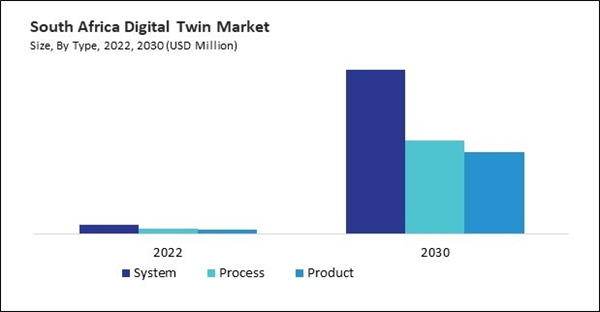The Brazil market dominated the LAMEA Digital Twin Market by Country in 2022, and would continue to be a dominant market till 2030; thereby, achieving a market value of $4,100.8 million by 2030. The Argentina market is experiencing a CAGR of 45.3% during (2023 - 2030). Additionally, The UAE market would exhibit a CAGR of 44.1% during (2023 - 2030).
A digital twin is a model or virtual representation of an analogous process, system, or physical object. It uses real-time data and simulations to replicate the characteristics and behaviours of its physical counterpart. Digital twins are used in various industries, including manufacturing, healthcare, and transportation, to optimize processes, improve performance, and facilitate decision-making.
Increasing adoption of IoT technologies, progress in AI and ML, and the demand for efficient and cost-effective solutions across industries are all contributing factors to the market's explosive growth. It is revolutionizing manufacturing, healthcare, automotive, and aerospace industries by providing valuable insights, enhancing decision-making, and improving operational efficiency.
Brazil's largest electricity sector in Latin America focuses on expanding the renewable energy sector, which already accounts for 83% of the country's electricity matrix. This growth in renewable energy sources, especially solar and wind, drives the demand for digital twin technology to optimize power generation and improve overall energy efficiency in the region.
Based on Type, the market is segmented into System, Process and Product. Based on Application, the market is segmented into Predictive Maintenance & Performance Monitoring, Business Optimization, Inventory Management, Product Design & Development and Others. Based on Industry, the market is segmented into Automotive & Transportation, Energy & Utilities, Residential & Commercial, Healthcare & Lifesciences, Agriculture, Manufacturing, Retail & Consumer Goods, Aerospace, and Others. Based on countries, the market is segmented into Brazil, Argentina, UAE, Saudi Arabia, South Africa, Nigeria, and Rest of LAMEA.
List of Key Companies Profiled
- Honeywell International, Inc.
- SAP SE
- PTC, Inc.
- General Electric Company
- IBM Corporation
- Oracle Corporation
- Siemens AG
- Robert Bosch GmbH
- Microsoft Corporation
- ABB Group
Market Report Segmentation
By Type- System
- Process
- Product
- Predictive Maintenance & Performance Monitoring
- Business Optimization
- Inventory Management
- Product Design & Development
- Others
- Automotive & Transportation
- Energy & Utilities
- Residential & Commercial
- Healthcare & Lifesciences
- Agriculture
- Manufacturing
- Retail & Consumer Goods
- Aerospace
- Others
- Brazil
- Argentina
- UAE
- Saudi Arabia
- South Africa
- Nigeria
- Rest of LAMEA
Table of Contents
Companies Mentioned
- Honeywell International, Inc.
- SAP SE
- PTC, Inc.
- General Electric Company
- IBM Corporation
- Oracle Corporation
- Siemens AG
- Robert Bosch GmbH
- Microsoft Corporation
- ABB Group
Methodology

LOADING...









